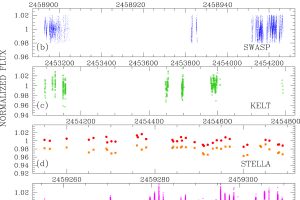TOI-1807b, the youngest Ultra-Short Period exoplanet discovered so far. “The GAPS Programme at TNG XXXVII. A precise density measurement of the young ultra-short period planet TOI-1807 b” of D. Nardiello (INAF -OAPd) appeared on A&A

Among the 5322 exoplanets discovered so far (from NASA), approximately 100 planets belong to the class of Ultra-Short Period (USP) exoplanets. These planets have very close orbits around their stars, with a period shorter than one day on Earth. They typically have a radius smaller than 2 Earth radii and are likely to be rocky cores of gaseous planets that lost their atmospheres due to their proximity to their parent stars, or terrestrial planets that migrated inward from their orbits.
To understand the formation of such ultra-short period (USP) exoplanets, it is necessary to find and characterize them around very young stars, which are typically only a few hundred million years old. The GAPS program (Global Architecture of Planetary Systems) includes a few of these young stars as targets. The program aims to find and characterize exoplanets using a series of spectroscopic observations made with the instrument HARPS-N, which is mounted on the Italian Telescopio Nazionale Galileo. These observations are supplemented by photometric series, typically from the NASA satellite TESS.
The team of researchers, led by the astronomer D. Nardiello from INAF – Astronomical Observatory of Padua, has studied the star BD+39 2643, which is approximately 300 million years old and belongs to a moving group – a group of co-moving stars that share the same origin. This study was conducted by analyzing a long series of photometric observations (55 days) from TESS, along with photometric observations from several ground-based telescopes (SuperWASP, the Kilodegree Extremely Little Telescope, the STELLA telescope, and the Schmidt 67/92 telescope of the Asiago observatory), and spectroscopic observations from HARPS-N. This rich set of observations allowed the researchers to confirm the presence of an exoplanet around the star (TOI-1807b) with an orbital period of only 13 hours, making it the youngest USP planet discovered so far. It was also possible to characterize the planet, which was found to have a mass of 2.6-2.7 Earth masses and a radius of 1.4 Earth radii, indicating that TOI-1807b is a terrestrial planet. Furthermore, there are no signs of an atmosphere, which may suggest that the planet lost its atmosphere due to a process called photoevaporation. This is due to the energetic (X-ray and UV) radiation emitted by the parent star and incident on the planet, raising the temperature of the atmosphere and causing it to evaporate from the planet. Previous studies show that BD+39 2643 is a bright X-ray emitter. The research is described in the paper: “The GAPS Programme at TNG. XXXVII. A precise density measurement of the young ultra-short period planet TOI-1807 b“, recently appeared on Astronomy & Astrophysics. Among the authors, there are the astronomers J. Maldonado, G. Micela, L. Affer and A. Maggio of INAF – Astronomical Observatory of Palermo.
The figure (click here to visualize the entire image) displays the light curve (which is a time series of photometric observations) of BD+39 2643, that were analyzed to confirm the presence of TOI-1807. Panel (a) shows the TESS light curves, with grey representing long cadence and black representing short cadence. Panel (b) shows the SuperWASP light curve, while panel (c) displays the KELT light curve. In panel (d), the STELLA light curve is shown, with the V band in orange and the I band in red. Finally, panel (e) shows the light curves from observations made with the Asiago telescope.
Mario Giuseppe Guarcello ( follow mariospiegacose) ( mariospiegacose) ( follow mariospiegacose)
Follow the Astronomical Observatory of Palermo on Facebok
Subscribe the Youtube channel of the Astronomical Observatory of Palermo<
